No way was photographer Vivian Maier gonna go out on top.
All images © Vivian Maier/Maloof Collection
For those unfamiliar with the Vivian Maier story, it’s a simple one that never changes. Vivian was a professional nanny who, in her off time, wandered around bad neighborhoods and metropolises snapping pictures of just about everyone from derelicts to fashionable women, cops, and lots of kids. Before she died in a Chicago nursing home in 2009, Maier had amassed over 120,000 images of strangers in streets, slums, and shadows. An extremely secretive woman, she never shared her activities, travels abroad, or any of her photos. With anyone. Not in fifty years of practicing street photography.
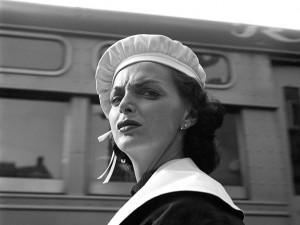 At the time of her passing, Maier was in possession of none of her work – not a single negative. This is to say, reel after reel of 8 and 16 mm film; personal writings and cassette tapes containing her voice recordings; personal observations on you-name-it; and seven hundred rolls of undeveloped color film. In 2007, it all had been forfeited to a storage company due to unpaid fees, for Vivian had begun this century almost destitute. She was powerless to stop the contents of the unit from being sold to a Chicago auction firm.
At the time of her passing, Maier was in possession of none of her work – not a single negative. This is to say, reel after reel of 8 and 16 mm film; personal writings and cassette tapes containing her voice recordings; personal observations on you-name-it; and seven hundred rolls of undeveloped color film. In 2007, it all had been forfeited to a storage company due to unpaid fees, for Vivian had begun this century almost destitute. She was powerless to stop the contents of the unit from being sold to a Chicago auction firm.
To those who knew her, or thought they did (namely, the grown children she’d cared for), she was a recluse, a hoarder, and a peculiar spirit. But to the many who now consider her one of the most prolific and talented street photographers in the history of the medium, she is an ambiguous monolith of isolation, genius, and resolve.
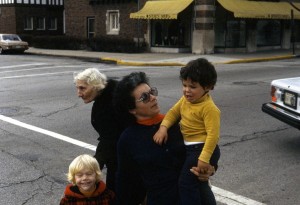
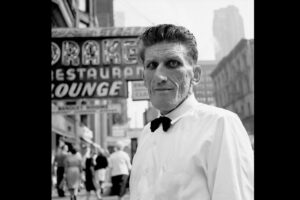 Vivian Maier’s gift would have likely been lost to obscurity had it not been for an amateur historian named John Maloof, who lived across from the auction house that sold him a huge amount of her life-work in 2007 – for a mere $380.
Vivian Maier’s gift would have likely been lost to obscurity had it not been for an amateur historian named John Maloof, who lived across from the auction house that sold him a huge amount of her life-work in 2007 – for a mere $380.
No need to go into what Maier’s pictures are like, ‘cause that’s for you to decide. But surely you’ll agree it would have been an tremendous loss for all that she’d produced, (plus the cataloging, receipts, instructions, and annotations) to wind up in a thousand thrift stores. Or worse. Ultimately, all the work it took to keep her undertakings and methodology a secret –and the rational behind it– now pushes Vivian’s mystique.
Maloof took it upon himself to care for and protect this treasure – to become Vivian’s custodian, as he’s described himself. And almost as soon as he started sharing his find, Maier became a phenomenon. She stunned the established photographic world, elbowing aside dismissals that she was a nutjob with a twin-lens camera. Her obvious expertise and ability to capture so many sidewalk sensations continues to contradict any and all criticism. Makes sense, she had 50 years to get it right. Talk about delayed gratification!
 As a big fan myself, I often scratch my head over how Maier could have let her creative devotion drift away without revealing it, or anticipating some credit. Circumstantial bad luck created the conditions that caused so much of her color film to go undeveloped, but had it been me, I would have given in. I imagine myself jumping up and down, flailing my arms to tell the world what I’d done, and then expect it to come to my rescue. But that’s just me. The blueprint of Vivian Maier’s anonymity is mind-bending.
As a big fan myself, I often scratch my head over how Maier could have let her creative devotion drift away without revealing it, or anticipating some credit. Circumstantial bad luck created the conditions that caused so much of her color film to go undeveloped, but had it been me, I would have given in. I imagine myself jumping up and down, flailing my arms to tell the world what I’d done, and then expect it to come to my rescue. But that’s just me. The blueprint of Vivian Maier’s anonymity is mind-bending.
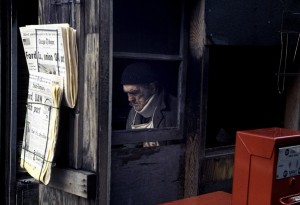 Thankfully, John Maloof will soon release a feature film documentary, entitled Finding Vivian Maier, and I can’t wait for the revelations he and his team have pulled from those boxes. Because until then, Vivian’s story stops right where it started. I’m accustomed to not having a happy ending here; as I say, the story doesn’t change. Vivian died unacknowledged and poor. But she’d been a world traveler, taking pictures of people with whom she identified the most, those who were alone or down on their luck. I’ll argue that she took the last laugh with her.
Thankfully, John Maloof will soon release a feature film documentary, entitled Finding Vivian Maier, and I can’t wait for the revelations he and his team have pulled from those boxes. Because until then, Vivian’s story stops right where it started. I’m accustomed to not having a happy ending here; as I say, the story doesn’t change. Vivian died unacknowledged and poor. But she’d been a world traveler, taking pictures of people with whom she identified the most, those who were alone or down on their luck. I’ll argue that she took the last laugh with her.
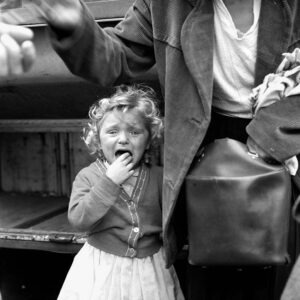 In February of 2011 I happened across one of the early online pieces covering Maloof’s discovery and what he then knew of Maier. It hit me like a truck. This woman had so secretly orchestrated her existence that none of the children she cared for as a professional nanny had any idea what was going on. Nor, for that matter, did their parents. False names, fake friendships and the intrigue of cityscapes made up the bulk of her life. But as Maier and the children took walks, or as she ran her personal errands, a camera hung at all times from her neck. And she was friendly enough with the vendors who sold her film, that some may have known her better than the families under her care. That is, if she let anyone know her at all.
In February of 2011 I happened across one of the early online pieces covering Maloof’s discovery and what he then knew of Maier. It hit me like a truck. This woman had so secretly orchestrated her existence that none of the children she cared for as a professional nanny had any idea what was going on. Nor, for that matter, did their parents. False names, fake friendships and the intrigue of cityscapes made up the bulk of her life. But as Maier and the children took walks, or as she ran her personal errands, a camera hung at all times from her neck. And she was friendly enough with the vendors who sold her film, that some may have known her better than the families under her care. That is, if she let anyone know her at all.
 Maier ostensibly loved the children she nurtured, but every time she went out her bedroom door was locked tight, hiding what must have looked like a World War II aerial photography library. Her charges were warned to stay away; Maier even made the installation of a deadbolt a deal breaker when considering a new nanny job. Over her dead body would she compromise the program, and what a program it was! She captured the temperament and humanity of a thousand career portraitists, yet managed to completely contain whatever excitement she must’ve felt at the end of each successful photo safari. Emerging from her darkroom, she was just a regular nanny.
Maier ostensibly loved the children she nurtured, but every time she went out her bedroom door was locked tight, hiding what must have looked like a World War II aerial photography library. Her charges were warned to stay away; Maier even made the installation of a deadbolt a deal breaker when considering a new nanny job. Over her dead body would she compromise the program, and what a program it was! She captured the temperament and humanity of a thousand career portraitists, yet managed to completely contain whatever excitement she must’ve felt at the end of each successful photo safari. Emerging from her darkroom, she was just a regular nanny.
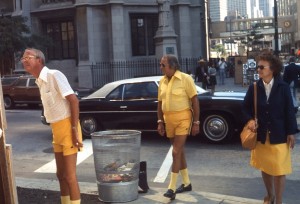 So again it makes you wonder: how had she acquired the ability to refrain from appreciation, or even measurement, of the skills she’d cultivated? Was she crazy? Or was she somehow so confident her in her talents that publicly charting her growth as a photographer was beside the point? Was her aim only to capture, and keep capturing, regardless of the outcome? Why? What was the secret behind the secret?
So again it makes you wonder: how had she acquired the ability to refrain from appreciation, or even measurement, of the skills she’d cultivated? Was she crazy? Or was she somehow so confident her in her talents that publicly charting her growth as a photographer was beside the point? Was her aim only to capture, and keep capturing, regardless of the outcome? Why? What was the secret behind the secret?
As such a pragmatic, insightful, and cautionary observer of people, so attuned to the everyday world, you’ve gotta figure that, in her later years, Maier must’ve known about the Internet. And she was, no doubt, wary of society’s increasing obsession with appearance and hunger for instant gratification. How could she not be? It’s pretty much the opposite of how she lived her own life, and not exactly what her images – with their many scenes of discomfort, joy, offense, and confusion – convey.
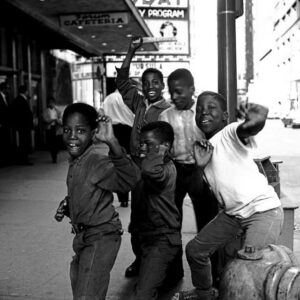
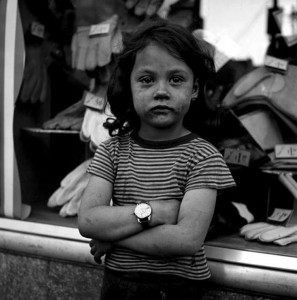 While I have room for only a few examples here, take a look and you’ll see, for one, how close Maier gets to total strangers. (And with actual machinery –a Leica or a Rolleiflex– not a cell phone!) That couldn’t have been done without knowing people, their spirits, and their personalities, yet Maier knew exactly when to snap that shutter on depravity, duty, defiance, and dehumanization. So I doubt that, by the time of her death, our increasingly impeded attention spans, narrow world of indulgence, and demand for immediacy were lost on Vivian Maier.
While I have room for only a few examples here, take a look and you’ll see, for one, how close Maier gets to total strangers. (And with actual machinery –a Leica or a Rolleiflex– not a cell phone!) That couldn’t have been done without knowing people, their spirits, and their personalities, yet Maier knew exactly when to snap that shutter on depravity, duty, defiance, and dehumanization. So I doubt that, by the time of her death, our increasingly impeded attention spans, narrow world of indulgence, and demand for immediacy were lost on Vivian Maier.
Which then makes me wonder if she secretly suspected her work would scratch an itch we would all feel today. I can only speculate, based on how I decode her photographic eye, but somehow Maier’s work makes me ashamed at how complicated, redundant, transient, and lazy life on America’s sidewalks have become.

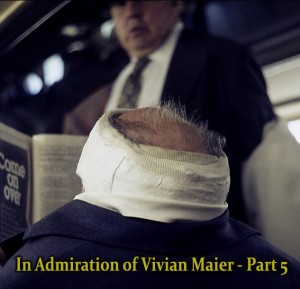
With any justice, Maier will finally earn the recognition she deserves. While Van Gogh was alive, his work was known only to friends and neighbors, colleagues, local art dealers, and collectors. It wasn’t until his sad, lonely death in 1890 that his work was put on display more broadly (generally as memorials). These subsequent retrospectives, shown internationally only a couple of years later, were the beginnings of a movement that would, and still does, embrace Van Gogh as one of histories most important artistic influences. Like Maier, he was an outcast and an introvert to his contemporaries. By enduring a compulsion to create in the face of the demons that drove her to isolation herself, she left us with important and mesmerizing images.
Can’t wait for the doc.